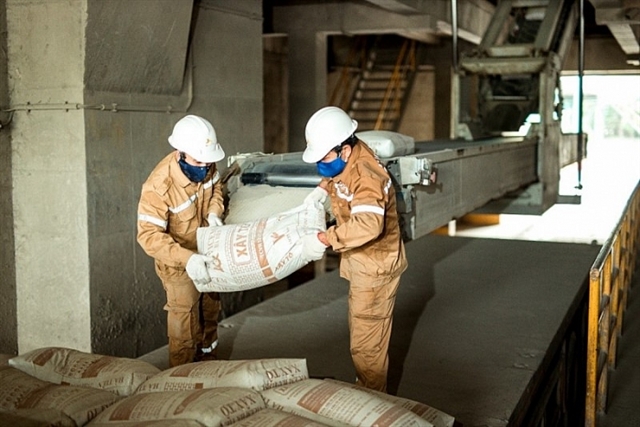 Economy
Economy


|
| Worker loading products on a conveyor belt at Hà Tiên 1's plant. Photo vicem.vn |
HÀ NỘI — Although sales are positive, rising input costs are weighing on cement enterprises’ business results in the third quarter.
In the first nine months of 2021, the whole cement industry exported 32,687 million tonnes of cement and clinker, with an export turnover of US$1.25 trillion, up 16.3 per cent year-on-year and 20.9 per cent, respectively, according to the Ministry of Industry and Trade.
In August and September, Việt Nam exported 4 - 4.3 million tonnes of cement each month, a sharp increase compared to the volume of 3.5 million tonnes in July and and 2.77 million tonnes in June. The third quarter was also the peak period of the COVID-19 outbreak in the country.
Lương Đức Long, General Secretary of the Việt Nam Cement Association (VNCA) said that cement exports rose sharply in the past two months because major export markets such as the European Union (EU), Canada, US and China have returned to normal operation. Therefore demand for cement increased, while product prices also inched higher.
Currently, Việt Nam is fifth biggest cement producer in the world, after China, India, US and Russia.
The rise in cement exports offset a decline of 5 per cent in domestic consumption in recent months as many provinces and cities implemented social distancing orders to prevent the pandemic. For the first nine months, cement consumption was unchanged over the same period last year at 45.58 million tonnes.
With an advantage of having a long coastline and many ports, Vietnamese cement exports are growing positively, especially to China.
Meanwhile China, the biggest consumer in the world, is facing an energy crisis, leading to production restrictions of some large power consuming industries such as steel and cement.
VNDirect Securities Corporation said that steel and cement inventories in China are at the lowest level since the beginning of the year, while selling prices climb. China is experiencing a temporary shortage of construction material supplies and the trend will last at least until the end of the fourth quarter of 2021 as China’s energy crisis shows no sign of ending.
With export momentum in the past nine months, the Ministry of Industry and Trade expected that the total export volume of cement and clinker will exceed 40 million tonnes this year.
In the domestic market, consumption volume is forecast to increase sharply in the last quarter of the year, as construction projects resume after many months of closure or operating in moderation to ensure disease prevention.
The end of the year is also the peak of the construction season, leading to an increase in cement consumption. In addition, as the Government pushes disbursement of public investment capital, the construction materials industries, including cement, will benefit.
Higher sales don't translate to higher profit
Cement is one of a few industries that still can maintain production and consumption during the outbreak of the pandemic. However the profit picture of enterprises in the industry is not so bright.
Việt Nam Cement Industry Corporation (VICEM) said that its profit before tax in the third quarter only reached 3 per cent of the quarterly plan, equaling 2.4 per cent over last year. The parent company's profit decreased by 62 per cent year-on-year, as subsidiaries posted losses of nearly VNĐ80 billion.
Of which, in the last quarter business statement, Vicem Bút Sơn Cement JSC (BTS) reported a fall of 14.6 per cent to VNĐ657.3 billion, resulting in a loss of VNĐ7.6 billion. In the same period last year, it recorded a profit of VNĐ12.4 billion. For the first nine months, its revenue was VNĐ2.1 trillion, down 5.7 per cent, while profit after tax slid 47.2 per cent to nearly VNĐ25.1 billion.
Similarly, in the third quarter, Vicem Hải Vân Cement JSC (HVX)’s revenue fell 5.9 per cent over last year to VNĐ152.8 billion, while it lost VNĐ1.2 billion. In the third quarter last year, it recorded a net profit of VNĐ798.7 million.
As of September 30, the company only made a profit of VNĐ404.9 million, down 90 per cent over the same period last year.
Hà Tiên 1 Cement (HT1) announced its third quarter consolidated net revenue of VNĐ1.04 trillion, down 48 per cent, with a loss of VNĐ19.7 billion. This marked the first quarterly loss in the past seven years. In the third quarter of 2020, it made a profit of VNĐ148.6 billion.
For the first nine months of 2021, HT1 recorded net revenue of VNĐ5.04 trillion and profit after tax of nearly VNĐ316.7 billion, down 14.1 per cent and 45.8 per cent, respectively.
Vietcombank Securities Company (VBSC) said that the country's clinker/cement export structure is 63 per cent/37 per cent, so the export value is not high. Therefore, the increase in cement exports doesn’t translate into higher profit.
Meanwhile, the price of raw materials, fuel and input materials for cement production jumped sharply in recent years. The disruption of global production and supply chains amid the pandemic has pushed up prices of basic commodities.
A coal industry analysis report of SSI Securities Company said that the global coal price has risen strongly compared to the domestic coal price, therefore, industries with a high ratio of imported coal like cement will suffer the most from higher production costs.
Of the production cost structure of cement enterprises, the cost of coal accounts for about 30 per cent, while limestone and clay account for only 12 per cent, and additive costs are 5 per cent.
Therefore, even though selling prices have risen since the beginning of the year, cement companies still reported losses, or reduced profits over the same period last year. — VNS